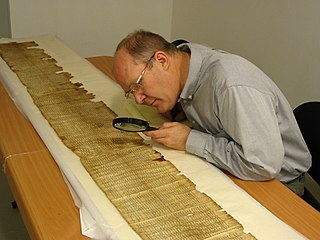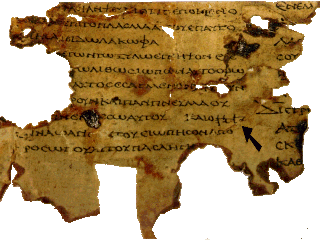
The Dead Sea Scrolls, also called the Qumran Caves Scrolls, are a set of ancient Jewish manuscripts from the Second Temple period. They were discovered over a period of 10 years, between 1946 and 1956, at the Qumran Caves near Ein Feshkha in the West Bank, on the northern shore of the Dead Sea. Dating from the 3rd century BCE to the 1st century CE, the Dead Sea Scrolls are considered to be a keystone in the history of archaeology with great historical, religious, and linguistic significance because they include the oldest surviving manuscripts of entire books later included in the biblical canons, along with extra-biblical and deuterocanonical manuscripts that preserve evidence of the diversity of religious thought in late Second Temple Judaism. At the same time, they cast new light on the emergence of Christianity and of Rabbinic Judaism. Almost all of the 15,000 scrolls and scroll fragments are held in the Shrine of the Book at the Israel Museum, located in the city of Jerusalem. The Israeli government's custody of the Dead Sea Scrolls is disputed by Jordan and the Palestinian Authority on territorial, legal, and humanitarian grounds — they were mostly discovered following the Jordanian annexation of the West Bank and were acquired by Israel after Jordan lost the 1967 Arab–Israeli War — whilst Israel's claims are primarily based on historical and religious grounds, given their significance in Jewish history and in the heritage of Judaism.

Emanuel Tov, is a Dutch–Israeli biblical scholar and linguist, emeritus J. L. Magnes Professor of Bible Studies in the Department of Bible at the Hebrew University of Jerusalem. He has been intimately involved with the Dead Sea Scrolls for many decades, and from 1991, he was appointed Editor-in-Chief of the Dead Sea Scrolls Publication Project.
4Q108 is a fragment containing a portion of the Song of Songs (3:7–8) in Hebrew. Fragments from three such scrolls were found in Cave 4 at Qumran. These, and 6Q6 from Cave 6, estimated from 2nd century BCE, comprise the total witness to the Song from the Dead Sea Scrolls, known so far.
4Q106 is one large and three small fragments from three columns of a scroll containing portions of the Song of Songs in Hebrew. It is one of three scrolls found in Cave 4 at Qumran that have been reconstructed as copies of the Song of Songs. These, and 6Q6 from Cave 6, comprise the total witness to the Song from the Dead Sea Scrolls, known so far.
Discoveries in the Judaean Desert (DJD) is the official 40-volume publication that serves as the editio princeps for the Dead Sea Scrolls. It is published by Oxford University Press.
6Q6 is a small portion of a scroll from Cave 6 at Qumran, containing Song of Songs 1:1-7 in Hebrew. Together with three scroll portions found in Cave 4, they comprise the total witness to the Song from the Dead Sea Scrolls. It is dated to about 50 CE.

Donald W. Parry is an American academic who is a professor of Hebrew Bible in the Department of Asian and Near Eastern Languages at Brigham Young University. He holds the Abraham O. Smoot Professorship. He is the author and editor of works related to the Dead Sea Scrolls and the Hebrew Bible, Old Testament. He has been a member of the International Team of Translators of the Dead Sea Scrolls since January 1994. He served as a member of the Dead Sea Scrolls Foundation Board of Advisors, 2008–present and presently serves as a member of the Dead Sea Scrolls Foundation Board of Trustees.
4Q41 or 4QDeuteronomyn, also known as the All Souls Deuteronomy, is a Hebrew Bible manuscript from the first century BC containing two passages from the Book of Deuteronomy. Discovered in 1952 in a cave at Qumran, near the Dead Sea, it preserves the oldest existing copy of the Ten Commandments.

The Greek Minor Prophets Scroll from Nahal Hever is a Greek manuscript of a revision of the Septuagint dated to the 1st century BC and the 1st century CE. The manuscript is kept in the Rockefeller Museum in Jerusalem. It was first published by Dominique Barthélemy in 1963. The Rahlfs-Siglum is 943.




